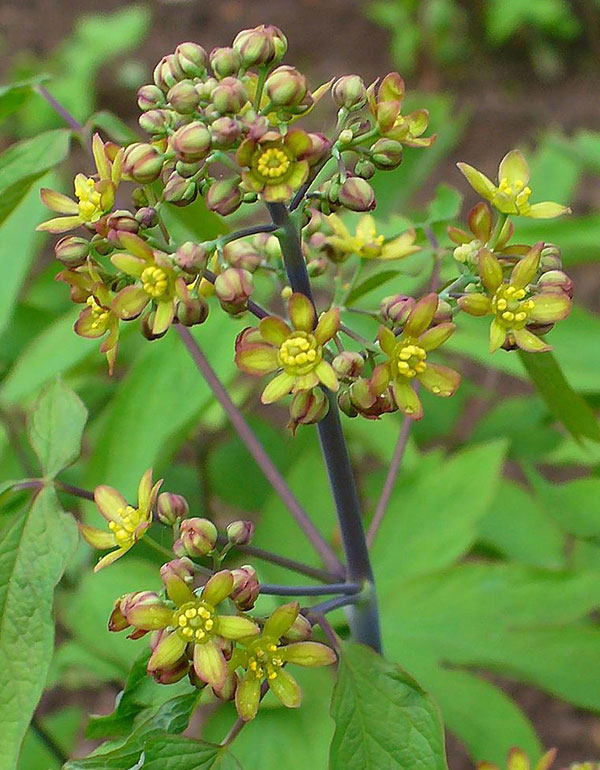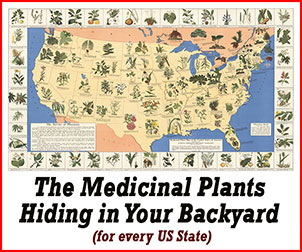Blue Cohosh

Blue Cohosh (Caulophyllum thalictroides)
Image - H. Zell
- lic. under CC 3.0

Background & General Info
Blue cohosh is a leafy perennial herb botanically known as Caulophyllum thalictroides and is native to eastern North America. Thriving in river or stream floodplains and deciduous forests, it is also called papoose root and squawroot. [1] The genus Caulophyllum, to which blue cohosh is a member species of, is scientifically renowned for their traditional use that dates back to ancient times. [2]
Nowadays, dietary supplements containing dried roots of blue cohosh or extracts from blue cohosh rhizomes have become commercially widely available, especially from Internet suppliers, and have turned out to be among the top-selling botanical supplements throughout the United States. [3][4]
Blue Cohosh - Botany
Blue cohosh can easily be identified as a striking wildflower possessing a remarkable display of spherical blue fruits held stiffly above the leaf canopy. Its compound leaves are arranged alternately, with one leaf per node along the smooth stem. The radially symmetrical flowers vary in color, from blue to purple, green to brown, and yellow. The dry fruit does not split open when ripe. [5]
Blue Cohosh - History & Traditional Use
The Native Americans have long medicinally used blue cohosh preparations, primarily to induce childbirth, alleviate labor pain, remedy delayed or irregular menstruation, and lessen heavy bleeding and pain during menstruation. [2] The Cherokee consider the plant as an herb that promotes childbirth and have utilized it to ease uterine inflammation, whereas the Menominee used the decoction of blue cohosh roots to diminish heavy bleeding during menstruation. The Chippewa regard blue cohosh as a contraceptive and treatment for lung ailments and indigestion. On the other hand, the Iroquois use this herb to treat rheumatism, gallstones, and fever. [1]
The extracts derived from blue cohosh roots are used in traditional medicine as an anti-inflammatory and antipyretic agent. [6] The United States Pharmacopoeia had listed blue cohosh as a labor inducer sometime between 1882 and 1905, and since then, this herb has been advertised and sold as an aid in childbirth. [2] A survey of midwives in the United States indicated that nearly 64% of midwives acknowledge the use of blue cohosh as a labor-inducing aid. [7]
Blue Cohosh - Herbal Uses
The black cohosh is traditionally prescribed as a remedy for discomfort during menopause and as a substitute for synthetic drugs in hormone replacement therapy. [4] It is also a common traditional treatment for rheumatic pain and inflammation. [6] Blue cohosh teas can be made by pouring 2 cups of boiling water over 1 teaspoon of granulated blue cohosh root in a container. [1]
Blue Cohosh - Constituents / Active Components
For the past decade, numerous saponins present in blue cohosh have been increasingly isolated and identified, as well as alkaloids and glycosides. [8] Methylcytosine, baptifoline, and anagyrine, which are lupin alkaloids, and magnoflorine, an aporphine alkaloid, were obtained by a very early study from the roots and rhizomes of blue cohosh through separation by partition column chromatography for the tertiary lupin alkaloids and through chromatography on alumina for magnoflorine. [9] A detailed phytochemical investigation by Alia and Khan (2008) led to the isolation of 15 compounds classified as alkaloids and triterpene saponins and, in particular, to the isolation of two alkaloids, namely, caulophyllumines A and B, and a saponin, cauloside H, from blue cohosh. [10] It appears however that the alkaloid methylcysteine and the glycoside caulosaponin, a steroidal saponin, are accredited for most of the physiological activities of this herb. [6]

Blue Cohosh - Medicinal / Scientific Research
Labor And Birth
Blue cohosh contains alkaloids and saponins, which are among its primary constituents responsible for its uterine-stimulating property. [3] The plant’s oxytocic effect or its ability to hasten childbirth has recently been attributed to the glycoside caulosaponin, which is a derivative of hederagenin, a triterpenoid saponin. [6]
Anticancer:
A 2009 study isolated 22 triterpene glycosides, 10 of which are new, from the underground parts of blue cohosh and evaluated these compounds for cytotoxicity against HL-60 human leukemia cells. Triterpene monodesmosides based on oleanolic acid (compounds 1 and 11–16) demonstrated cytotoxic effects against HL-60 cells, with IC50 values ranging from 3.4 to 15.9 μg/mL. [11]
Anti-inflammatory:
Blue cohosh contains many alkaloids and glycosides whose chemical structure resembles that of anti-inflammatory glucocorticoids. Lee et al. (2012) presented evidence on the anti-inflammatory response of blue cohosh treatment and its ability to concentration-dependently inhibit the elevation of iNOS expression after the activation of microglia with lipopolysaccharide, as evaluated through western blotting or gene expression. BV2 microglial cells were treated with blue cohosh constituents at a concentration of 1–50 μg/mL for one day; such treatment led to a dose-dependent inhibition of nitric oxide generation in activated microglia. Additionally, blue cohosh treatment suppressed the expression of COX-2, iNOS, and proinflammatory cytokines such as TNF-α, IL-1β, and IL-6 in adrenal glands of mice, suggesting its anti-inflammatory effects via inhibition of expression of iNOS and proinflammatory cytokines and its therapeutic utility in the treatment of inflammation-related diseases. [6]
Blue Cohosh - Contraindications, Interactions, And Safety
Ingestion of blue cohosh preparations, according to recent studies, can probably result in birth defects and neonatal heart failure due to their specific alkaloid content, and depending on the form (e.g., root and liquid extract) and doses, the maximum daily intake of alkaloids and saponins from dietary supplements containing blue cohosh can substantially vary from < 1 to 75 mg/day for alkaloids and from about 9 to 420 mg/day for saponins. [3] Analysis through quantitative methods has shed some light on the constituents in dietary supplements with blue cohosh; among the potential toxicants found recently are N-methylcytisine, a nicotinic alkaloid, and anagyrine, a teratogenic alkaloid, although the latter has only been detected in some but not all blue cohosh dietary supplements. [8]
According to a 2008 systematic review of the safety and efficacy of blue cohosh during pregnancy and lactation, the medicinal use of blue cohosh by pregnant women should be coupled with extreme care and medical professional supervision is highly advised. Blue cohosh in vitro can exert teratogenic, embryotoxic, and oxytoxic effects. [7]
References:
[1] A. J. Cichoke, Secrets of Native American Herbal Remedies: A Comprehensive Guide to the Native American Tradition of Using Herbs and the Mind/Body/Spirit Connection for Improving Health and Well-Being, New York: Avery, 2001. https://www.penguinrandomhouse.com/books/348481/secrets-of-native-american-herbal-remedies-by-anthony-j-cichoke/9781583331002/
[2] Y.-G. Xia, G.-Y. Li, J. Liang, B.-Y. Yang, S.-W. Lü and H.-X. Kuang, "Genus Caulophyllum: An overview of chemistry and bioactivity," Evidence-Based Complementary and Alternative Medicine : eCAM, vol. 2014, p. 684508, 2014. https://www.researchgate.net/publication/262734025
[3] S. Satchithanandam, E. Grundel, J. Roach, K. White, E. Mazzola, M. Ganzera and J. Rader, "Alkaloids and saponins in dietary supplements of blue cohosh (Caulophyllum thalictroides)," Journal of AOAC International, vol. 91, no. 1, p. 21–32, 2008. https://www.ncbi.nlm.nih.gov/pubmed/18376582
[4] A. Ankli, E. Reich and M. Steiner, "Rapid high-performance thin-layer chromatographic method for detection of 5% adulteration of black cohosh with Cimicifuga foetida, C. heracleifolia, C. dahurica, or C. americana," Journal of AOAC International, vol. 91, no. 6, p. 1257–1264, 2008. https://www.ncbi.nlm.nih.gov/pubmed/19202784
[5] G. Botany, "Caulophyllum thalictroides (L.) Michx.," New England Wild Flower Society, 2017. https://gobotany.newenglandwild.org/species/caulophyllum/thalictroides/
[6] Y. Lee, J.-C. Jung, Z. Ali, I. A. Khan and S. Oh, "Anti-inflammatory effect of triterpene saponins isolated from blue cohosh (Caulophyllum thalictroides)," Evidence-Based Complementary and Alternative Medicine : eCAM, vol. 2012, p. 798192, 2012. https://www.ncbi.nlm.nih.gov/pubmed/22988475
[7] J. Dugoua, D. Perri, D. Seely, E. Mills and G. Koren, "Safety and efficacy of blue cohosh (Caulophyllum thalictroides) during pregnancy and lactation," Canadian Journal of Clinical Pharmacology, vol. 15, no. 1, p. e66–73, 2008. https://www.ncbi.nlm.nih.gov/pubmed/18204101
[8] J. Rader and R. Pawar, "Primary constituents of blue cohosh: quantification in dietary supplements and potential for toxicity," Analytical and Bioanalytical Chemistry, vol. 405, no. 13, p. 4409–4417, 2013. https://www.ncbi.nlm.nih.gov/labs/articles/23420136/
[9] M. S. Flom, R. W. Doskotch and J. L. Beal, "Isolation and characterization of alkaloids from Caulophyllum thalictroides," Journal of Pharmaceutical Sciences, vol. 56, no. 11, p. 1515–1517, 1967. https://onlinelibrary.wiley.com/doi/10.1002/jps.2600561130/abstract
[10] Z. Ali and I. A. Khan, "Alkaloids and saponins from blue cohosh," Phytochemistry, vol. 69, no. 4, p. 1037–1042, 2008. https://www.ncbi.nlm.nih.gov/pubmed/18048069
[11] Y. Matsuo, K. Watanabe and Y. Mimaki, "Triterpene glycosides from the underground parts of Caulophyllum thalictroides," Journal of Natural Products, vol. 72, no. 6, p. 1155–1160, 2009. https://www.ncbi.nlm.nih.gov/pubmed/19449879

Article researched and created by Dan Ablir for herbshealthhappiness.com.
© herbshealthhappiness.com


1. Famous Chef Sheds 60lbs Researching New Paleo Recipes: Get The Cookbook FREE Here
2. #1 muscle that eliminates joint and back pain, anxiety and looking fat
3. Drink THIS first thing in the morning (3 major benefits)
4. [PROOF] Reverse Diabetes with a "Pancreas Jumpstart"
5. Why Some People LOOK Fat that Aren't
6. Amazing Secret Techniques To Protect Your Home From Thieves, Looters And Thugs
7. The #1 WORST food that CAUSES Faster Aging (beware -- Are you eating this?)
If you enjoyed this page:






























